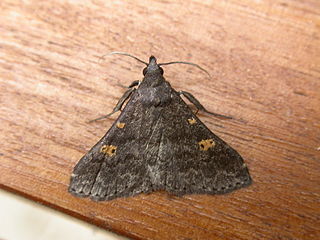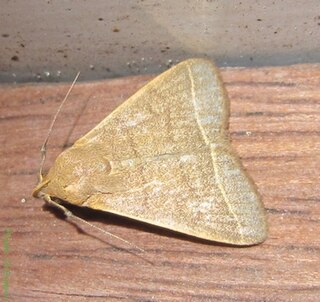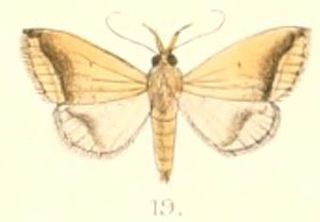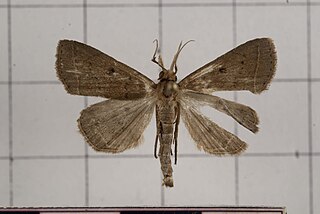
Naarda is a large genus of erebid moths currently encompassing 108 species. Initially identified by Francis Walker in 1866, it is in the family Erebidae. Somewhat ruddy in appearance, this genus is distinguishable for its generally slender thorax and abdomen, and straight, porrect labial palpi. Most species are a light tan color, but shading can reach as deep as a charcoal, with muddy yellow, conspicuous reniform, orbicular stigmata featured on the forewings, sometimes reflected bilaterally superior.

Homodes is a genus of moths of the family Erebidae first described by Achille Guenée in 1852.
Hypenagonia is a genus of moths of the family Erebidae first described by George Hampson in 1893. The adult moths have pale brown wings with a dark band across each wing. The wingspan of these moths is about 1 centimeter.
Nolasena is a monotypic moth genus of the family Erebidae. Its only species, Nolasena ferrifervens, is found in India, Sri Lanka, Borneo and the Philippines. Both the genus and species were first described by Francis Walker in 1858.

Simplicia is a genus of litter moths of the family Erebidae. The genus was erected by Achille Guenée in 1854.

Simplicia mistacalis is a litter moth of the family Erebidae. It was first described by Achille Guenée in 1854 and is found in Asia, from India and Sri Lanka to Taiwan and New Guinea, including China, Myanmar, Japan, the Philippines and Malaysia.
Cyana subornata is a moth of the family Erebidae first described by Francis Walker in 1854. It is found in India, Borneo and Sri Lanka.
Daona mansueta is a moth of the family Noctuidae first described by Francis Walker in 1864. It is found in Sri Lanka, Borneo, India, Myanmar, Peninsular Malaysia, the Philippines, Sumbawa, Seram, New Guinea and Australia.

Diomea rotundata is a moth of the family Noctuidae first described by Francis Walker in 1857. It is found in Sri Lanka, the Indian subregion, Taiwan, Sumatra, Borneo, the Philippines and Sumba.
Anomis combinans, the yellow-banded semi-looper moth, is a moth of the family Erebidae. The species was first described by Francis Walker in 1858. It is found in Australia, Sri Lanka, Borneo, New Guinea, Malaysia and Timor.
Nygmia xanthomela is a moth of the family Erebidae first described by Francis Walker in 1862. It is found in Sri Lanka, Borneo, Java, Sumatra and Peninsular Malaysia.

Avitta quadrilinea is a moth of the family Noctuidae first described by Francis Walker in 1863. It is found in Borneo, Peninsular Malaysia, Thailand, the Indian subregion, the Philippines, Sulawesi and Sri Lanka.

Hipoepa biasalis is a moth of the family Noctuidae first described by Francis Walker in 1859. It is found in Oriental tropics of India and Sri Lanka to Taiwan, Sumatra, Borneo, the Philippines and Sulawesi.

Hydrillodes gravatalis is a moth of the family Erebidae first described by Francis Walker in 1859. It is found in the Indian subregion, Sri Lanka and Sundaland.

Simplicia butesalis is a moth of the family Erebidae first described by Francis Walker in 1859. It is found in Borneo, Sumatra, Peninsular Malaysia and Sri Lanka.
Arrade erebusalis is a moth of the family Erebidae first described by Francis Walker in 1863. It is found in Sri Lanka, Nicobar Islands, Singapore, Borneo, New Guinea, Bismarck Islands and Australia.
Artigisa nigrosignata is a moth of the family Erebidae first described by Francis Walker in 1864. It is found in Sri Lanka, Borneo and India.
Catada vagalis is a moth of the family Erebidae first described by Francis Walker in 1858. It is found in India, Sri Lanka, Peninsular Malaysia, Borneo and the Philippines.
Hypena mandatalis, is a moth of the family Erebidae first described by Francis Walker in 1859. It is found in the Indian subregion, Pakistan, Sri Lanka, Borneo, Sulawesi and Australia.
Cophanta funestalis is a moth of the family Noctuidae first described by Francis Walker in 1864. It is found in Indo-Australian tropics of India, Sri Lanka, Thailand, Borneo, New Guinea and Australia.













